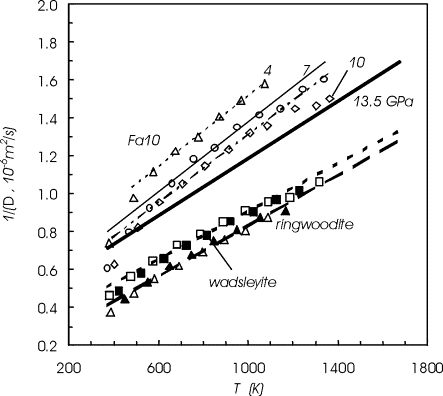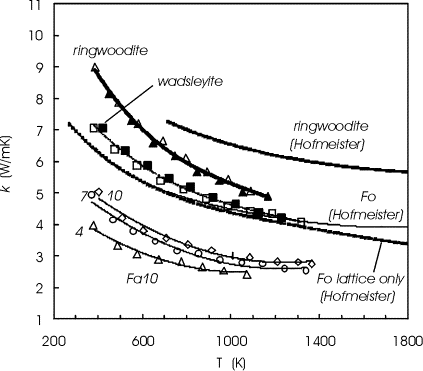

We have previously reported a technique to perform thermal diffusivity measurements in a multi-anvil apparatus and resulting data for olivine (see Annual Report 1999). Here we report our new results for the high pressure polymorphs (Mg0.9Fe0.1)2SiO4 wadsleyite and ringwoodite measured up to 20 GPa and 1400 K using the 5000 ton multianvil press.
Figure 3.1-7 shows the thermal diffusivities of wadsleyite and ringwoodite together with those of olivine. Thermal diffusivity D increases with pressure and reciprocal thermal diffusivity is ordinarily proportional to temperature. Thus, the olivine data at 4, 7 and 10 GPa, respectively, were fitted to 1/D = (0.11 + 1.94 x 10-4 T)/(1.76x10-7+ 5.87x10-9 P), where D is thermal diffusivity (m2/s), T is temperature in K, P is pressure in GPa. The pressure derivatives of olivine at 400, 500, and 600 K are 2.45, 2.26, and 2.11x10-8 m2 s-1 GPa-1, respectively, which are smaller than earlier estimates of 5.4, 4.1, and 3.2x10-8 m2 s-1 GPa-1. The thermal diffusivities of olivine at atmosphere pressure are 7.35, 6.80, and 6.33x10-7 m2 s 1, at 400, 500, and 600 K respectively, which are also smaller than the values of 11.38, 9.36, and 8.37x10-7 m2 s-1 previously reported in the literature.
 |
The thermal diffusivity of wadsleyite measured at 14 GPa is significantly higher than that of olivine and was fitted to 1/D = 0.27+6.37x10-4T (Fig. 3.1-7). If we extrapolate the olivine data to conditions at the 410 km discontinuity (13.5 GPa, 1400°C), the thermal diffusivity increases ~27% when olivine transforms to wadsleyite. The thermal diffusivity of ringwoodite measured at 20 GPa was fitted to 1/D = 0.16+6.70x10-4T and is higher than that of wadsleyite at 14 GPa. However, the thermal diffusivity of ringwoodite might be similar to that of wadsleyite at the same pressure but so far we do not know pressure derivatives for either wadsleyite or ringwoodite.
In order to compare our results to the thermal conductivities of Mg2SiO4
olivine and ringwoodite computed by Hofmeister (Science, 283, 1699-1706,
1999), we compute thermal conductivity from thermal diffusivity using  ,
where
,
where  is thermal conductivity,
is thermal conductivity,  is density, CP is heat capacity.
The results show that our measured values are lower than Hofmeister's estimations,
and the differences become larger at higher temperatures (Fig. 3.1-8).
One reason is that our samples contain 10% iron and iron reduces thermal
diffusivity from that of Mg end member samples, as observed for various
silicates. Our results also show that when olivine transforms to ringwoodite,
its thermal conductivity increases ~40% which is close to Hofmeister's
estimate of ~46% increase.
is density, CP is heat capacity.
The results show that our measured values are lower than Hofmeister's estimations,
and the differences become larger at higher temperatures (Fig. 3.1-8).
One reason is that our samples contain 10% iron and iron reduces thermal
diffusivity from that of Mg end member samples, as observed for various
silicates. Our results also show that when olivine transforms to ringwoodite,
its thermal conductivity increases ~40% which is close to Hofmeister's
estimate of ~46% increase.
 |

Tel: +49-(0) 921 55 3700 / 3766, Fax: +49-(0) 921 55 3769, E-mail: bayerisches.geoinstitut(at)uni-bayreuth.de
 Previous page
Previous page